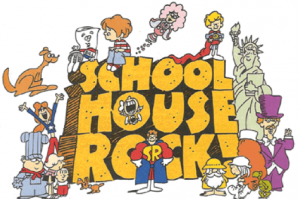[Originally published as “My Roundabout Introduction to Blossom Dearie” on Laura Grey’s Little Hopping Bird blog.]
When I was a child, ABC’s Saturday morning cartoon line-up was punctuated with wonderful short musical cartoons sponsored by Nabisco: the famous “Schoolhouse Rock” cartoons. The educational songs created for these cartoons were so clever, catchy, and memorable that they were all rereleased on video in the 1990s for the children of the children who enjoyed them over 30 years ago. I grew up on the “Multiplication Rock” and “Grammar Rock” videos; my daughter loved them 30 years later.
Much of the appeal of these videos was that each was just the length of a pop song, and the music and lyrics were written by proven and talented professional musicians, not by earnest professional pedagogues. They were quick and full of information, and had busy, funny animation. And they were the only regular music videos for kids on TV then; there were weak shows with live-action singers or talentless oafs in bad costumes doing pathetic songs, like on “New Zoo Revue,” and there were catchy theme songs on the somehow compelling yet also vaguely disturbing Sid and Marty Krofft kid shows like “H.R. Pufnstuf” (which starred Jack Wild, who played The Artful Dodger in the musical film “Oliver!”), “The Bugaloos” (whose villain was played by comedian Martha Raye, probably most famous to people my age as a denture adhesive pitchwoman) and “Liddsville,” that bizarre show about the land of talking hats starring Charles Nelson Reilly and Butch Patrick (a.k.a. Eddie Munster). But MTV didn’t exist yet and catchy musical TV ads for dolls or games (from “Life” to “Mystery Date“) were no match for three-minute musical cartoon masterpieces like “Three is a Magic Number” or “Conjunction Junction” or “I’m Just a Bill.” These songs were so good that a number of popular rock bands covered them on the album “Schoolhouse Rock Rocks.”
Of all the songs in the “Schoolhouse Rock” oeuvre, there was one that shone out as a particularly elegant little gem: “Figure Eight.” My mother loved it so much that she bought the “Schoolhouse Rock” album on vinyl many years ago just to listen to that song. This ode to the number eight was illustrated by a figure skater and the song was sung by a woman with an unbelievably darling name and voice: Blossom Dearie. The dearest part is that she was born with that name. And the best part is that sweet, small, clear voice has sung some of the lightest, crispest, most refreshing versions of a number of jazz standards I’ve ever heard. She also has a fresh, spare style of piano playing that underscores that little pussycat voice.
I remember seeing Blossom Dearie interviewed on TV in the 1970s; she had wit and sparkle, and I was rather amazed that her tiny little voice seemed not to be a put-on but the real deal. When I started listening to her recordings of jazz standards years later, I found there was less cutesiness than I expected, and more of a wistful, light yet wry quality to her singing. I love the way she delivers Dorothy Fields‘ lyrics in “I Won’t Dance” (“For heaven rest us, I’m not asbestos”) and the light but knowing quality of “They Say It’s Spring.” “Rhode Island is Famous for You” makes my daughter and me laugh, and it’s fun to compare her version of that song to Michael Feinstein’s. While I love Feinstein’s direct, swoony, passionate if sometimes campy treatment of lyrics, and think he does that song well, Blossom Dearie’s delivery has a quiet humor and a conspiratorial wink, whereas Feinstein’s is more of a showman’s romp, bigger and bolder and more obvious. Both have their place, but Dearie’s intimacy makes me feel like I’m in on a more sophisticated joke.

